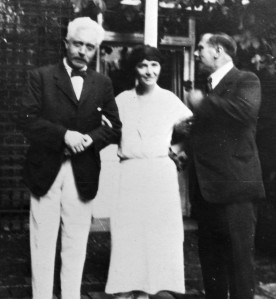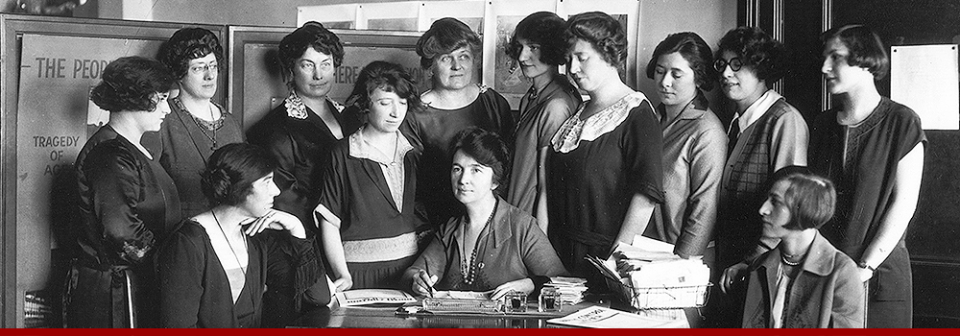
Sanger with H. G. Wells and actor Otis Skinner. She met Wells in 1920, though this picture might have been taken later. (Courtesy of the Sophia Smith Collection, Smith College).
Here at the Project, reading through the chronology of Margaret Sanger’s activities can be overwhelming. At first glance, her tireless efforts spring from the pages of our office timeline in the simplest of forms: dense listings of the year, month, and day of a particular event, accompanied by the city and country, and a brief detail of Sanger’s activity. When we are researching a specific event, or need to find out what she was doing on a particular day, the timeline is a the perfect place to start. This is especially helpful as we wrap up the research for Volume 4: Birth Control Around the World, or when we need a quick source of reference to disprove unfounded allegations regarding her whereabouts. Ah, the excitement of historical research!
Sometimes when we focus too closely on the details of a particular date, the timeline has a devious way of masking the flurry of activity cloaked behind its uncomplicated descriptions. For example, snippets such as “Meeting on Hygiene of Pregnancy and the Danger of Abortion” from July 7, 1920, and two “afternoon meetings” from the 8th have a forthright way of outlining her activity, but can leave much to the imagination.
Consider July of 1920, for example– a month that can surely leave any one of us sitting behind a screen feeling inadequate or “not worthy” in a Wayne’s World sort of way. It was a time when some parts of the world were still embroiled in turmoil (Pancho Villa and the Mexican Revolution) while others were recovering from it (the final meetings at Versailles occurred only a few months prior to close WWI, and Bolshevist Russia concurrently attempted to juggle the aftermath of the Russian Revolution). Margaret Sanger went forth with her international plans for birth control. In the first half of July, she visited five cities in the United Kingdom, attended a myriad of luncheons and dinners, spoke at meetings, and lectured to five different audiences within a fifteen day span.
Yes, you read that all correctly. Five cities within a fifteen day span. Sanger began her United Kingdom tour in London where she spoke about the importance of clinics, then she was off to Brighton for an Infant Welfare Conference, then to Birmingham and to Glasgow to address shipyard workers at Glasgow Green. The next day, still in Glasgow, she lectured to women on “What Every Girl should Know,” and then on “The Problems of Marriage” on the sixth. On the seventh, she spoke about the “Hygiene of Pregnancy and the Danger of Abortion.” Two meetings later, she was off to Rosyth, and then back to Glasgow for– you guessed it– more meetings, some of which were on “Safe Methods” which she later described as “splendid.” How else might one describe safe methods?
Now, let’s consider the ongoing work ensuing behind the scenes. Sanger had an impeccable ability to maintain correspondence (how many times has this appeared on your New Year’s Resolution list?). Her scores of personal and professional letters would be bursting at our office seams if they were not on microfilm! Oh, and let’s not forget to mention that two of her thirteen publications– What Every Girl Should Know and Woman and the New Race— hit the press later that same year, which she undoubtedly had on her mental radar. Toss in the inefficiencies of 1920 travel, undocumented commitments, and the random particularities of one’s daily routine, then it’s no wonder that as she left for London from Glasgow on July 13th, she wrote that she was “very tired” and troubled by her “weary throat.”
Yet, acting in accordance to one of her mantras, “No matter what happens, the work shall go on,” Sanger attended four engagements and was off for Essex two days later. Though heart problems and a variety of other ailments would plague her work at times, she continued to work in this fashion for almost forty years until her retirement in 1959.
Sanger identified many emotional experiences we are now familiar with that fueled her crusade: her mother dying at a young age after bearing eleven children, the masses of women and children she saw suffering because women could not obtain birth control information– one of the most dramatic experiences occurring with a resident of the Lower East Side, Sadie Sachs, that you can read about here. The suffering she experienced as nurse and helpless bystander to her mother’s death certainly drove Sanger’s crusade.
But Sanger also knew from her wide travels that there were areas in the world where women and children did not suffer on the same scale as the slums she had witnessed. In an early speech from 1915 entitled Comstockery in America, Sanger explained what aided in her determination:
“I resolved, after a visit to France, where children are loved and wanted and cared for and educated, to devote my time and effort in giving this information to women who applied for it. I resolved to defy the law, not behind a barricade of law books and technicalities, but by giving the information to the workers directly in factory and workshop…”
And that was exactly what she did. At a time when in many circles the word “summer” corresponded to “leisure,” Sanger was always on the move. By touring the world tirelessly, giving speeches, holding rallies, and attending luncheons, dinners, teas, Sanger plotted the points of her life’s work. By impeccably maintaining her personal and professional correspondence, she has given us insight into her motivations and worries, and provided the detailed backdrop for those points that otherwise may appear as unexciting to the untrained eye.
More important, upon revisiting the chronological details of her life’s work during these blistering months, Sanger still has the ability to make us pause and consider the events of our own lives: just how are we spending our month of July?
*For more details regarding Sanger’s speech entitled, Comstockery in America, visit Columbia University’s digital knowledge ventures.
*You can read more about Sanger’s work in July of 1920 in her article entitled “Clinics and the Solution” which appeared in the Birth Control Review, July 1920, 6-8 and can also be viewed on our website.


>…Sadie Sachs, that you can read about here.
there is no link there
Sorry about that! It is fixed.
ok
you could delete the comment